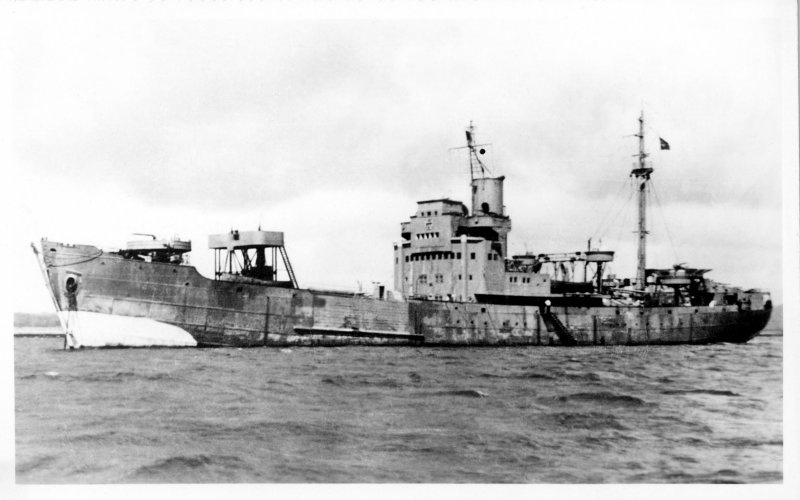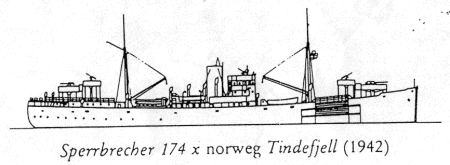
Here is an important yet unloved and therefore undiscussed Kriegsmarine Auxilliary Vessel Type:
Hopefully, beyond any potential interest in the vessel type, an exploration into aerial mine ordnance , minelaying procedures , and effects on shipping and the future possibility of their inclusion in IL2 - never done before in a flight sim as far as I know - can be considered.


Then we'll need these to drop them...


The Sperrbrecher (over 100 trawlers converted)
before...

... and after my attack

(from Wikipedia , with edits)

A Sperrbrecher (German; informally translated as "pathfinder"), was a German auxiliary ship of the Second World War that was intended to serve as a type of minesweeper, by sailing ahead of other vessels through minefields, intending to detonate any mines in their path. Also used as anti-aircraft ships, the Sperrbrecher suffered heavy losses in the war.

Officially designated as 'Special Purpose Merchant Ships', although termed by the Royal Air Force as 'Heavy Flak Ships',the Sperrbrecher were converted from merchant ships for their special role, were primarily crewed by merchant seamen, and often had their cargo holds filled with buoyant material to aid in flotation in case of hitting a mine. The bows were also strengthened. Ships converted to the Sperrbrecher type were usually fitted with heavy anti-aircraft armament, and often carried barrage balloons.

The primary use of the Sperrbrecher was to escort other vessels through cleared paths in defensive minefields, for the purpose of detonating any mines that might have strayed into the passageways.In addition, the ships of the Sperrbrecher type would, early in the war, be used to clear suspected enemy minefields by simply sailing through them. Even with the strengthened hull and buoyant material, however, the ships suffered heavy losses in this role, and with the advent of acoustically and magnetically fused mines, this role became ineffective.Later in the war the Sperrbrecher type ships were used to escort U-boats in and out of harbor.
In an attempt to counter newer, magnetically fused mines, some ships of the Sperrbrecher were equpped with a large electromagnet fitted in their bows.Referred to as the VES-System, this was intended to detonate magnetic mines well clear of the vessel, the design specifications calling for a distance of 460 metres (500 yd) from the hull at detonation.However, careful military intelligence work by the Royal Navy resulted in a method to defeat this method of minesweeping, sinking several Sperrbrecher through the careful fusing of mines laid as traps, their fuses desensitized to be activated only when the sweeping vessel was directly above them.
Over one hundred vessels, mostly merchant ships of around 5,000 tonnes (5,500 short tons) and larger displacement, were converted to serve in the Sperrbrecher role, and it is estimated that around 50 percent of the vessels converted were lost during the war.

During World War II only one commander received the Knight's Cross of the Iron Cross for services on a Sperrbrecher. Korvettenkapitän of the Reserves Karl Palmgreen received the award on 3 August 1941 as commander of
Sperrbrecher IX and I.

Following the end of the war, some of the surviving Sperrbrecher were converted back to merchant duties, and some of these vessels continued in their more peaceful service until the 1970s.

Specifications (for Sperrbrecher 32 , a typical conversion)
Class : Sperrbrecher (Pathfinder)
Displacement: 7,500 tonnes (8,300 short tons)
Length: 115.1 metres (378 ft)
Beam: 15.3 metres (50 ft)
Draught: 6.5 metres (21 ft)
Propulsion: One diesel engine, one shaft, 3,500 shaft horsepower (2,600 kW)
Speed: 14 knots (26 km/h)
Armament: 2x 105 mm (4.1 in) AA
2x 37 mm (1.5 in) AA
15x 20 mm (0.79 in) AA (!!! that's a lot of 20 mike mike)
Notes: Representative type of converted ships.
Let's Get 'em...

Kopfdorfer
 Author
Topic: Sperrbrecher Auxilliary Vessels (Read 8684 times)
Author
Topic: Sperrbrecher Auxilliary Vessels (Read 8684 times)


